Catalpa rescue
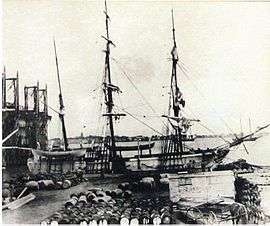
The Catalpa rescue was the escape, in 1876, of six Irish Fenian prisoners from what was then the British penal colony of Western Australia.
Fenians and Plans to Escape
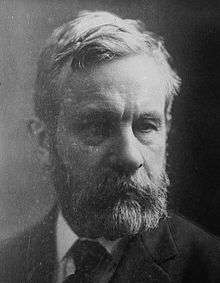
From 1865 to 1867, British authorities rounded up supporters of the Irish Republican Brotherhood, an Irish independence movement, and transported sixty-two of them to the penal colony of Western Australia. They were convicted of crimes ranging from treason-felony to outright rebellion. Sixteen were soldiers who were court martialed for failing to report or stop the treason and mutinous acts of the others. Among them was John Boyle O'Reilly, later to become the editor of the Boston newspaper The Pilot. They were sent on the convict ship Hougoumont, arriving at Fremantle on 9 January 1868, at the Convict Establishment (now Fremantle Prison).[1][2]
In 1869, O'Reilly escaped on the whaling ship Gazelle with assistance of the local Catholic priest, Father Patrick McCabe, and settled in Boston. Soon after his arrival, O'Reilly found work with The Pilot newspaper and eventually became editor. In 1871, another Fenian, John Devoy, was granted amnesty in England, among others, on condition that he settle outside Ireland, and he sailed to New York City. He also became a newspaperman, for the New York Herald. He joined the Clan na Gael, an organization that supported armed insurrection in Ireland.[3]
In 1869, pardons had been issued to many of the imprisoned Fenians. Another round of pardons were issued in 1871, after which only a small group of "military" Fenians remained in Western Australia's penal system. In 1873, Devoy received a smuggled letter from imprisoned Fenian James Wilson, who was among those the British had not released. He asked them to aid the escape of the remaining Fenian prisoners. Devoy discussed the matter with O'Reilly and Thomas McCarthy Fennell, and Fennell suggested that a ship be purchased, laden with a legitimate cargo, and sailed to Western Australia, where it would not be expected to arouse suspicion. The Fenian prisoners would then be rescued by stealth rather than force of arms. Devoy approached the 1874 convention of the Clan na Gael and got the Clan to agree to fund a rescue of the men. He then approached whaling agent John T. Richardson, who told them to contact his son-in-law, whaling captain George Smith Anthony, who agreed to help.[1][4]
James Reynolds, a member of the Clan and on the committee to rescue the prisoners, bought under his name for the Clan a three-masted whaling bark Catalpa for $5,500, and George Anthony recruited twenty-two sailors. On 29 April 1875, Catalpa sailed from New Bedford, Massachusetts. At first, most of the crew was unaware of their real mission. Anthony noticed too late that the ship's marine chronometer was broken, so he had to rely on his own skills for navigation. First they sailed to Fayal Island in the Azores, where they off-loaded 210 barrels of sperm whale oil. Unfortunately, much of the crew deserted the ship, and they had to leave three sick men behind. Anthony recruited replacement crew members and set sail for Western Australia.[4]
At the same time, two Fenian agents, John Breslin and Tom Desmond, had arrived in Western Australia in September. Breslin masqueraded as an American businessman "James Collins", with suitable letter of introduction, and got acquainted with Sir William Cleaver Robinson, Governor of Western Australia. Robinson took Breslin on a tour of the Convict Establishment (now Fremantle Prison). Desmond took a job as a wheelwright and recruited five local Irishmen who were to cut the telegraph lines connecting Perth to Albany on the day of escape (there was no link to the eastern colonies of Australia until 1877).
Catalpa fell behind the intended schedule due to a serious storm, in which she lost her foremast. She dropped anchor off Bunbury on 27 March 1876. Anthony and Breslin met. The pair began to prepare for the rescue.[5][6][7][8][9][10][11][12][13]
Escape and pursuit
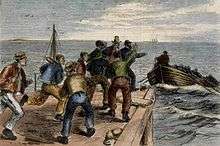
The first intended day for escape was 6 April, but the appearance of HMS Convict and other Royal Navy ships and customs officers quickly led to a postponement. The escape was rearranged for 17 April, when most of the Convict Establishment garrison was watching the Perth Yacht Club regatta.
Catalpa dropped anchor in international waters off Rockingham and dispatched a whaleboat to shore. At 8:30 am, six Fenians who were working in work parties outside the prison walls, absconded – Thomas Darragh, Martin Hogan, Michael Harrington, Thomas Hassett, Robert Cranston and James Wilson – were met by Breslin and Desmond and picked up in horse traps. A seventh Fenian, James Kiely, had been exposed as an informer by his fellow prisoners and left behind. The men raced 20 kilometres (12 mi) south to Rockingham pier where Anthony awaited them with the whaleboat. A local he had spoken to earlier saw the men and quickly alerted the authorities.[1]
On the return to the Catalpa a fierce squall struck, breaking the whaleboat’s mast. The storm lasted till dawn on 18 April and was so intense that Anthony later stated that he didn't expect the small boat to survive. At 7 am, with the storm over, they again made for the Catalpa but an hour later spotted the screw steamer SS Georgette, which had been commandeered by the colonial governor, making for the whaler. The men lay down in the whaleboat and it was not seen by the Georgette. The Georgette found the Catalpa, but in Captain Anthony’s absence the First Mate refused to allow the colonial police to board as the ship was outside the colony’s three-mile limit. The steamer was forced to return to Fremantle for coal after following the Catalpa for several hours.[1]
As the whaleboat again made for the ship a police cutter with 30 to 40 armed men was spotted. The two boats raced to reach the Catalpa first, with the whaleboat winning, and the men climbing aboard as the police cutter passed by. The cutter turned, lingered briefly beside the Catalpa, and then headed to shore.
Early on 19 April the refueled and now heavily armed Georgette returned and came alongside the whaler, demanding the surrender of the prisoners and attempting to herd the ship back into Australian waters. They fired a warning shot with the 12 pounder (5 kg) cannon that had been installed the night before. Ignoring the demand to surrender, Anthony had raised, and then pointed towards, the U.S. flag, informed the Georgette that an attack on the Catalpa would be considered an act of war against the USA, and proceeded westward.
Governor Robinson had ordered the police on the Georgette not to create an incident outside territorial waters. After steaming around threateningly for about an hour, the Georgette headed back to Fremantle and Catalpa slipped away into the Indian Ocean.[1]
Aftermath
The Catalpa did its best to avoid Royal Navy ships on its way back to the USA. O'Reilly received the news of the escape on 6 June (Stevens 2003, p. 352) and released the news to the press. The news sparked celebrations in the United States and Ireland and anger in Britain and Australia (although there was also sympathy for the cause within the Australian population). The Catalpa returned to New York on 19 August 1876.[14]
George Smith Anthony remained in New Bedford with his wife and children, never returning to sea. He was appointed New Bedford Port Inspector in 1886. With the help of a journalist, Z. W. Pease, he published an account of his journey, The Catalpa Expedition, in 1897.[15]
The Catalpa was presented as a gift to Captain Anthony, John Richardson and Henry Hathaway. It was eventually sold and turned into a coal barge. Not of great value in this capacity, Catalpa was finally condemned at the port of Belize, British Honduras.[16]
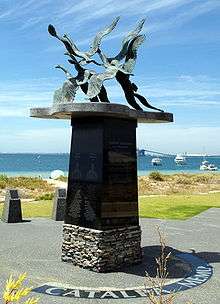
Memorials
On 9 September 2005 a memorial was unveiled in Rockingham to commemorate the escape. The memorial, a large statue of six wild geese, was created by Western Australian artists Charlie Smith and Joan Walsh Smith. The geese refer to the phrase "The Wild Geese", which was a name given to Irish soldiers who served in European armies after being exiled from Ireland. The Fenians transported to Western Australia adopted the phrase for themselves during their voyage on board the Hougoumont, even publishing a shipboard newspaper entitled The Wild Goose.
In 1976 a memorial stone was erected to commemorate the 100th anniversary of the rescue in New Bedford, Massachusetts, home port of Catalpa.[17]
Exhibition
From 22 September 2006 to 3 December 2006 an exhibition, called "Escape: Fremantle to Freedom," opened at Fremantle Prison displaying many artifacts relating to the Catalpa rescue. The exhibition received over 20,000 visitors.

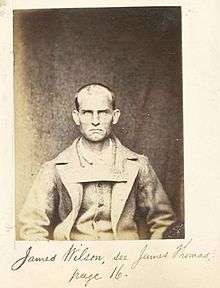
 Michael Harrington
Michael Harrington Robert Cranston
Robert Cranston Thomas Darragh
Thomas Darragh Thomas Hassett
Thomas Hassett Martin Hogan
Martin Hogan
In song
So come all you screw warders and jailers
Remember Perth regatta day
Take care of the rest of your Fenians
Or the Yankees will steal them away.
On the seventeenth of April last the Stars and Stripes did fly
On board the bark Catalpa, waving proudly to the sky;
She showed the green above the red as she did calmly lay
Prepared to take the Fenian boys in safety o'er the sea.
Traditional Full lyrics
Catalpa escape legacy
| Wikisource has original text related to this article: |
- Musician and local historian Brendan Woods authored a Theater Production about the breakout titled The Catalpa Directed by Gerry Atkinson with a cast of 22. On 15 November 2006 The Catalpa play premiered at Fremantle Town Hall the play ran until 25 November. The play was based on the diaries of Denis Cashman, with the poetry of John Boyle O'Reilly set to music and dance supported by a five-part Musical ensemble. The show sold out on three of its four night run.[18]
- Irish rebel music band The Wolfe Tones recorded a song about the Catalpa incident called The Fenians' Escape.
- The Real McKenzies, a Celtic punk band from British Columbia, Canada, included their rendition of the song "The Catalpa" on the 2005 Fat Wreck Chords album "10,000 Shots".
- Donal O'Kelly's one man play Catalpa was an international success, winning a Scotsman Fringe First Award at the 1996 Edinburgh Festival Fringe and the Critic's Prize at the Melbourne International Festival in 1997.
- Western Australian folk music band, The Settlers released the album Bound For Western Australia in 1978 that included the song The Catalpa[19]
- Australian folk band, The Bushwackers featured the song The Catalpa on the album Beneath the Southern Cross.[20]
- An Australian Broadcasting Corporation production, The Catalpa Rescue, was shown on ABC Television on Thursday 25 October 2007.[21]
- Fenian Park, Bunbury, listed in Geographic Name Approvals in Western Australia July/September 1999 and October/December 1999 Volume 15, numbers 3 and 4 ISSN 0817-265X - page 6 "'Reserve 45390 adjacent Kurrajong Circle, Glen Iris: in 1876 several Fenians ...fled to America aboard the whaling barque Catalpa: City of Bunbury
References
- 1 2 3 4 5 Reid, Richard (17 March 2011). "'A noble whale ship and commander' – The Catalpa rescue, April 1876" (pdf). Not Just Ned: A true history of the Irish in Australia. National Museum of Australia. Retrieved 15 February 2016.
- ↑ "Hougoumont - arrived in WA in 1868". Convicts to Australia. Perth, WA: Perth Dead Persons' Society. Retrieved 15 February 2016.
- ↑ Birman, Wendy (1974). "O'Reilly, John Boyle (1844–1890)". Australian Dictionary of Biography. Melbourne University Press. Retrieved 15 February 2016.
- 1 2 Pease, Zephaniah Walter (1897). "The Catalpa expedition". New Bedford, MA: George S. Anthony. p. 89. Retrieved 15 February 2016.
- ↑ "Catalpa: Escape of the Fenians from Western Australia". Archived from the original on 28 September 2007. Retrieved 2 July 2008.
- ↑ "The Fenians - Characters - History - Fremantle Prison". Archived from the original on 6 October 2007. Retrieved 2 July 2008.
- ↑ "The Wild Geese Today - Book Reviews". Retrieved 2 July 2008.
- ↑ McCormack, Joseph (April 1999). "Escape from Australia". The Hedgemaster. Garden City, New York: Irish Cultural Society of the Garden City Area. Retrieved 22 September 2010.
- ↑ Meagher, Paul T. (4 September 2010). "A Brief Compilation Of The Major Points Of The Catalpa Rescue Story". New Bedford, MA: Friendly Sons of Saint Patrick. Retrieved 22 September 2010.
- ↑ http://www.wgi.org.au/Origin.html
- ↑ "Chapter 31". Retrieved 2 July 2008.
- ↑ "Catholic Encyclopedia: John Boyle O'Reilly". Retrieved 2 July 2008.
- ↑ "Daniel Chester French: The John Boyle O'Reilly Memorial". Retrieved 2 July 2008.
- ↑ King, Gilbert (12 March 2013). "The Most Audacious Australian Prison Break of 1876". Smithsonian.com. Washington, DC: Smithsonian Institution. Retrieved 22 August 2016.
- ↑ Fennell, Philip; King, Marie; Golway, Terry (2008). John Devoy's Catalpa Expedition. New York: NYU Press. p. 172. ISBN 9780814727744. Retrieved 22 August 2016.
- ↑ Laws, John; Stewart, Christopher (2007). It Doesn't End There. Macmillan. p. 166. ISBN 9781742625645. Retrieved 15 February 2016.
- ↑ "Friendly Sons of Saint Patrick". New Bedford, MA. 1976. Retrieved 16 February 2016.
- ↑ Catalpa Productions
- ↑ "The Settlers – Bound For Western Australia". Discogs. 1978. Retrieved 18 February 2016.
- ↑ "The Bushwackers – Beneath The Southern Cross". Discogs. 1981. Retrieved 18 February 2016.
- ↑ Gallacher, Lyn (28 July 2013). "The Catalpa escape". Hindsight. Australian Broadcasting Corporation. Retrieved 18 February 2016.
Further reading
| Wikisource has original text related to this article: |
- John Devoy - John Devoy's Catalpa Expedition (ISBN 0-8147-2748-4)
- John Devoy - Recollections of an Irish Rebel
- Laubenstein, William J - "The Emerald Whaler" London : Deutsch, 1961.
- Seán O'Luing - "Fremantle Mission"
- Stevens, Peter F. (2003). The Voyage of the Catalpa. Carroll & Graf Publishers. ISBN 978-0-7867-1130-7. Retrieved 22 September 2010.
- View the Memorial Launch Video
- Vincent McDonnell - The Catalpa Adventure - Escape to Freedom Cork: The Collins Press, 2010.
- Richard Cowan - "Mary Tondut - The Woman in the Catalpa Story" , Sydney, June 2008 ISBN 9780646494203.
Video and media
| Wikimedia Commons has media related to Catalpa rescue. |
- Irish Escape Documentary produced by the PBS Series Secrets of the Dead